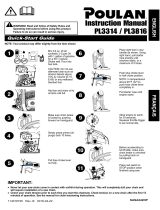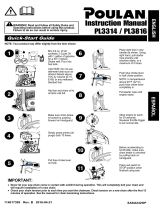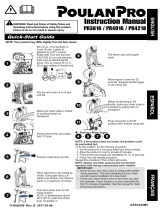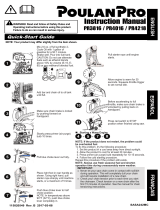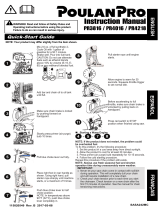Page is loading ...


Page 2
Rev 2
OPERATION NOTES
Read these notes before you start working with the chainsaw,
and keep the notes for future reference.
Read the instructions carefully and familiarise yourself with all of
the control elements so that you are able to safely operate the
device. Always keep these operating instructions together with
the chainsaw
Risk of hearing defects. Under normal operating conditions this
device can expose the operator to a noise level of 80 dB (A) or
more.
Noise protection must be worn (SEE NOTE 1). Please observe
local regulations when operating this device.
Intended/Not intended use.
This product is designed to for use by a trained operator for cutting logs and felling
trees.
The chainsaw is used to;
o Saw trunks
o Square timbers
o Cutting branches
o Only material’s form wood may be worked on.
Operators of this machine, MUST read this operators manual and be fully trained and
familiar with this chainsaw and think over all possible dangers.
Sufficient Personal Protective Equipment (PPE) is to be worn and according to the
operating instructions during use.
Damage or injuries resulting from mis-use are the responsibility of the operator. No
liability shall be taken by the supplier or manufacturer for mis-use.
Only use saw chains and guide bars recommended in the operating instructions for
the model of machine.
Any modifications to the machine will void the manufacturer’s warranty.
This equipment is designed for use in the home garden.

Page 3
Rev 2
CONTENTS
Section Description
Page N
o
/N
o’s
OPERATION NOTES
2
1. SAFETY
4 - 6
2. SAFE OPERATION
6 - 9
3. MACHINE PARTS
10
4. INSTALLING GUIDE BAR AND CHAIN
11 - 14
5. FUEL & CHAIN OIL
14
6. OPERATION
15 - 16
7. SAWING
17 - 19
8. GENERAL MAINTENANCE
20 - 25
9. STORAGE
26
10. ENVIROMENTAL DISPOSAL
26
11. WARRANTY
26
12. TROUBLE SHOOTING
27
13. SPECIFICATIONS
28
14. GENPOWER CONTACT DETAILS
29
15. DECLARATIONS
30
NOTE 1
31

Page 4
Rev 2
1. SAFETY.
1.1. The operator of the machine;
1.1.1. Is responsible for and has a duty of care in making sure that the machine is operated safely
and in accordance with the instructions in this user manual.
1.1.2. Should never leave it in a condition which would allow an untrained or unauthorised
person/s to operate this machine.
1.1.2.1. Should take care and show due diligence for the safety of and with regard to those
around whilst using the machine, to include but not limited to;
1.1.2.1.1. Elderly, children, pets, livestock and property.
1.2. Some or all of the following PPE, Warning Signs and symbols may appear throughout this manual
and you must adhere to their warning/s. Failure to do so may result in personal injury. SEE NOTE 1.
Personal Protective clothing (PPE)
Warning Signs and Symbols

Page 5
Rev 2
1.3. Carbon Monoxide
1.3.1. Carbon monoxide is a colourless and odourless gas. Inhaling this gas can cause death as well
as serious long term health problems such as brain damage.
1.3.2. The symptoms of Carbon monoxide poisoning can include the following;
1.3.2.1. Headaches, Dizziness, Nausea, Breathlessness, Collapsing or Loss of consciousness.
1.3.2.2. Carbon monoxide symptoms are similar to flu, food poisoning, viral infections and
simply tiredness. That’s why it’s quite common for people to mistake this very dangerous
poisoning for something else.
1.3.3. To avoid Carbon monoxide poisoning DO NOT Use Petrol/Diesel powered equipment inside
a home or garage even if doors and windows are open.
1.3.4. If you think you or someone around you has been affected by carbon monoxide poisoning;
1.3.4.1. Get fresh air immediately.
1.3.4.2. Open doors and windows, turn off machine and leave the affected area.
1.3.4.3. See your doctor immediately or go to hospital - let them know that you suspect
carbon monoxide poisoning.
1.3.5. DO NOT use in an enclosed area or a moving vehicle.
1.4. General fuel safety.
1.4.1. Fuel Safety additional information can be obtained from the Health and Safety Executive
(HSE) document SR16.
1.4.2.
All fuels are Flammable.
1.4.3. Keep away from all ignition sources i.e. Heaters, Lamps, sparks from Grinding or welding.
1.4.4. Hot work on tanks that have contained fuel is extremely dangerous and should not be
carried out.
1.4.5. Keep work area clean and tidy.
1.4.6. Clean up all spills promptly using correct methods i.e. absorbent granules and a lidded bin.
1.4.7. Dispose of waste fuels correctly.

Page 6
Rev 2
1.5. Petrol safety.
1.5.1.1. Always fuel and defuel in well-ventilated area.
1.5.1.2. Always wear correct, suitable and fit for purpose Personal Protective Equipment
(PPE), suggested items are as follows, but are not limited too.
1.5.1.3.
Hand protection.
1.5.1.4.
Protective clothing.
1.5.1.5.
Respiratory protective equipment should be used when in an unventilated
area.
1.5.1.6. When defueling always use a propriety fuel retriever.
1.5.1.7. Always carry fuel in the correct and clearly marked container.
2. SAFE OPERATION
2.1. Keep your body warm, especially your head, neck, feet, ankles, hands and wrists.
2.2. Maintain good blood circulation by performing vigorous arm exercises during frequent work
breaks. Keep the saw chain sharp and the saw, including the AV (Anti-Vibration) system, well
maintained.
2.3. A blunt chain will increase cutting time, and pressing a blunt chain through wood will increase the
vibrations transmitted to your hands.
2.4. A saw with loose components or with damaged or worn AV buffers will also tend to have higher
vibration levels.
2.5. Limit the hours of operation.
2.6. All the above mentioned precautions do not guarantee that you will not sustain white finger
disease or carpal tunnel syndrome. Therefore, continual and regular users should monitor closely
the condition of their hands fingers. If any of the above symptoms appear, seek medical advice
immediately.
Before using our products, please read this manual carefully to understand the
proper use of your chainsaw.
Never operate a chainsaw when you are tired, ill, upset, or under the influence of
medication that may make you drowsy, or if you are under the influence of alcohol
or drugs.
Operate the chainsaw only in well ventilated areas. Never start or run the engine
inside a closed room or building or a poorly ventilated area. Exhaust fumes contain
dangerous carbon monoxide which can kill.
Never use in high wind, bad weather, when visibility is poor or in very high or low
temperatures. Always check the tree for dead branches which could fall during the
felling operation.

Page 7
Rev 2
Use safety and slip-resistant footwear, protective trousers, snug fitting clothing and
eye, hearing and head protection devices. Use the anti-vibration (AV) glove. It is
believed that a condition called Raynaud’s phenomenon, which affects the fingers of
certain individuals may be brought about by exposure to vibration and cold. Loss of
colour and numbness in the fingers. The following precautions are strongly
recommended because the minimum exposure which might trigger the ailment is
unknown.
Always use caution when handling fuel. Wipe up all spills and then move the chain
saw at least 3 metres from the fuelling point before starting the engine.
Eliminate all sources of sparks or flame (e.g. smoking, open flames, or work that can
cause sparks) in the areas where fuel is mixed, poured, or stored. Do not smoke
while handling fuel or while operating the chain saw.
Do not allow other persons to be near the chain saw when starting the engine or
cutting a wood. Keep bystanders and animals out of the work area. Children, pets,
and bystanders should be a minimum of 10 metres away when you start or operate
the chain saw.
Never start cutting until you have a clear work area, secure footing, and planned
retreat
path from the falling tree.
Always hold the chainsaw firmly with both hands when the engine is running. Use a
firm grip with thumb and fingers gripping the chain saw handles.
Keep all parts of your body away from the saw chain when the engine is running.
Before you start the engine, make sure the saw chain is not contacting anything.
Always carry the chain saw with the engine stopped, the guide bar and saw chain to
the rear, and the muffler away from your body.
Always inspect the chain saw before each use for worn, loose, or changed parts.
Never operate a chain saw that is damaged, improperly adjusted, or is not
completely and securely assembled. Be sure that the saw chain stops moving when
the throttle control trigger is released.
All chainsaw service, other than the items listed in the Operator’s Manual, should be
performed by competent chainsaw service personnel. (e.g., if improper tools are
used to remove the flywheel, or if an improper tool is used to hold the flywheel in
order to remove the clutch, structural damage to the flywheel could occur which
could subsequently cause the flywheel to disintegrate).
Always shut off the engine before setting it down.

Page 8
Rev 2
Use extreme caution when cutting small size brush and saplings because slender
material may catch the saw chain and be whipped toward you or pull you off
balance.
When cutting a branch that is under tension, be alert for spring back so that you will
not be struck when the tension in the wood fibres is released.
Keep the handles dry, clean and free of oil or fuel mixture.
Guard against kickback. Kickback is the upward motion of the guide bar which occurs
when the saw chain at the nose of the guide bar contacts an object. Kickback can
lead to dangerous loss of control of the chain saw.
When transporting your chain saw, make sure the appropriate guide bar cover is in
place. Securely place the machine during transport to prevent loss of fuel, damage or
injury.
KICKBACK
2.7. Kickback may occur when the nose or tip of the guide bar touches an object, or when the wood
closes in and pinches the saw chain in the cut.
2.8. Tip contact in some cases may cause a lightning fast reverse reaction, kicking the guide bar up and
back towards the operator.
2.9. Pinching the saw chain along the top of the guide bar may push the guide bar rapidly back towards
the operator.
2.10. Either of these reactions may cause you to lose control of the saw which could result in
serious personal injury.
2.11. Do not rely exclusively on the safety devices built into your saw.
2.12. As a chain saw user you should take several steps to keep cutting jobs free from accident or
injury.
With a basic understanding of kickback you can reduce or eliminate the element of surprise.
Sudden surprise contributes to accidents.
Keep a good grip on the saw with both hands, the right hand on the rear handle, and
the left hand on the front handle, when the engine is running.
Use a firm grip with thumbs and fingers encircling the chain saw handles.
A firm grip will help you reduce kickback and maintain control of the saw. Don’t let
go.

Page 9
Rev 2
Make certain that the area in which you’re cutting is free from obstructions. Do not
let the nose of the guide bar contact a log, branch, or any other obstruction which
could be hit while you are operating the saw.
Cut at high engine speeds.
Do not overreach or cut above shoulder height.
Follow manufacturers sharpening and maintenance instructions for saw chain.
Only use replacement bars and chains specified by the manufacturer or the
equivalent.
3. MACHINE PARTS
3.1. All Models.
1
Guide Bar Scabbard
9
Oil Tank Filler Cap
2
Guide Bar
10
Starter Pull Cord
3
Chain
11
Fuel Tank Filler Cap
4
Front Hand Guard and Chain
Brake Lever
12
Engine Switch
5
Front Handle
13
Throttle trigger
6
Air Filter Cover
14
Throttle Tigger Lock-out
7
Air Filter Lock Nut
15
Primer Bulb
8
Choke Knob
16
Chain adjuster

Page 10
Rev 2
4. INSTALLING GUIDE BAR AND CHAIN
The saw chain has very sharp edges. Use protective gloves for
safety. See NOTE 1.
4.1. A standard saw unit package contains the items listed below;
1
Chain Orientation
2
Clockwise = Tighten,
Anti-Clockwise =
Loosen.
3
Chain Tensioning
Screw
4
Guide Bar Securing
Nuts
1
Power Unit
2
Saw Chain
3
Guide Bar
4
Guide Bar Cover
5
Spark Plug Socket
6
File

Page 11
Rev 2
Pay attention to the correct direction of the saw chain
4.1.1. Push the Brake guard forwards away from the front handle to check that the chain brake is
ON.
4.1.2. Loosen the nut two nuts and remove the chain cover. When removed take out the transit
spacer (Yellow).
4.1.3. Fit the guide bar to the power unit, then fit the chain to the sprocket and, while fitting the
saw chain around the guide bar, mount the guide bar to the power unit.
4.1.4. Install the chain cover, pulling end of guide bar away from power unit fasten the mounting
nuts to finger tightness.
1
Sprocket
2
Transit Spacer
3
Spiked Bumper and
Cover

Page 12
Rev 2
4.1.5. Tighten the chain by using the chain tensioning screw in a clockwise direction.
4.1.6. Do this until the chain can be pulled away from the guide bar by until the tie straps just
touch the bottom side of the bar rail.
4.1.7. Then check the chain for smooth rotation and proper tension while moving it by a gloved
hand. Operate the brake to make sure it locks.
4.1.8. Tighten the nuts securely with the bar tip held up.
4.1.9. Run chain saw for 10 minutes and readjust with the chain until correct tension is achieved.
4.2. Chain Brake.
4.2.1. The chain brake is a device which stops the chain instantaneously if the chain saw recoils
due to kickback.
4.2.2. Normally, the brake is activated automatically by inertial force.
4.2.3. It can also be activated manually by pushing the brake lever (Front handle guard) down
toward the front.
4.2.4. When the brake operates, a white cone pops up from the base of the brake lever.
4.2.5. To release brake, pull up the front handle guard toward the front handle until a “click” is
heard.
4.3. Checking chain oil supply.
4.3.1. After starting the engine, run the chain at medium speed
and see if chain oil is scattered off as shown in the figure.
4.3.2. The chain oil flow can be changed by inserting a screwdriver
in the hole on bottom of the clutch side.
4.3.3. Adjust according to your work conditions.
4.3.4. (1) Chain oil flow adjusting shaft.
4.3.5. (2) Anti-clockwise – Increase.
4.3.6. (3) Clockwise – Decrease.
When the brake operates, release the throttle lever to slow down the engine
speed.
Continuous operation with the brake engaged will generate heat from the
clutch and will cause serious damage to the clutch and surrounding structure.

Page 13
Rev 2
4.4. Confirm Chain Brake.
4.4.1. Turn off the engine and push brake handle forward.
4.4.2. Holding the chainsaw in a horizontal position, let go of the
front handle and rest the chain on a piece of wood or tree
stump, push the chainsaw forward, the brake should hold the
chain firm on the bar. Resistance level can vary depending on
bar size.
4.4.3. If the chain brake is not effective, ask your dealer to inspect
the machine and adjust or repair the brake.
It is very important to maintain the proper chain tension.
Rapid wear of the guide bar or the chain coming off easily can be caused by
improper tension. Especially when using a new chain, take good care of it since
it may stretch when first used.
5. FUEL & CHAIN OIL
The fuel is highly flammable.
Do not smoke or bring any flame or sparks near fuel.
The use of without 2 stroke oil cause severe damage to the engine inner parts.
DO NOT use 4 stroke engine oil.
5.1. Fuel Mixture ratios.
5.1.1. Pre-mix 2-stroke oil with fresh unleaded petrol as follows:
5.1.1.1. Mineral based 2-stroke oil : 25:1 (40ml of oil per 1 litre of petrol)
5.1.1.2. Synthetic 2-stroke oil: 40:1 (25ml of oil per 1 litre of petrol)
5.2. How to mix Fuel and Oil.
5.2.1. Using the correct measuring container, measure out the correct quantities of petrol and 2-
stroke oil to be mixed.
5.2.2. Put some of the unleaded petrol into a clean, approved fuel container.
5.2.3. Pour in all of the oil and shake well.
5.2.4. Pour in the rest of petrol and shake again for at least one minute.
5.2.5. Put a clear indication on the outside of the container to avoid mixing up with unmixed
petrol or other containers.
Do not use waste or regenerated oil - this may cause damage to the oil pump
and increase chain and bar wear.
5.3. Only use correct and special chainsaw oil.
The oil tank should become nearly empty by the time fuel is used up.
Make sure to refill the oil tank every time you re-fuel the chainsaw.

Page 14
Rev 2
6. OPERATION
6.1. Starting
6.1.1. Put machine on a flat surface with the fuel
and oil caps facing upwards.
6.1.2. Untwist and remove the fuel cap (1).
6.1.3. Put fuel/oil mix into the fuel tank.
6.1.4. Refit cap and fasten cap securely.
6.1.5. Untwist and remove the oil cap (2).
6.1.6. Put the required amount chain oil tank or to 80% of the full capacity.
6.1.7. Refit cap and fasten cap securely.
6.1.8. Wipe up any fuel or oil spillages on or around the unit.
6.1.9. Put the switch to the “I” position.
6.1.10. Continuously pump the priming bulb (1) until fuel
comes in the bulb.
6.1.11. Pull out the choke knob (2).
6.1.12. The choke will close and the throttle lever will then be
set in the starting position.
6.1.13. Push the front handle guard forward to activate the
chain brake.
6.1.14. While holding the saw unit securely on the ground, pull
the starter rope firmly.
6.1.15. When firing occurs, push in the choke knob and pull the
starter again to start the engine.
6.1.16. Pull up the front handle guard toward the front handle to release the chain brake. Then,
allow the engine to warm up with the trigger pulled slightly.
Before you start the engine, make sure the saw chain is not touching anything.
Make sure the chain brake is always activated each time you start the engine.
When restarting immediately after stopping the engine. Set choke in the open
position.
Once the choke knob has been pulled out, it will not return to the operating
position even if you press down on it with your finger.
When you wish to return the choke knob to the operating position, operate
the throttle trigger & throttle trigger lockout instead. NB It will push in but will
not deactivate.

Page 15
Rev 2
6.2. Checking the functionality of the Clutch.
6.2.1. Before each use, you should confirm that there is no chain movement when the engine is
running at idling speed.
6.3. Adjusting carburettor.
6.3.1. The carburetor on your unit has been factory adjusted, but may require fine tuning due to
change in operating conditions.
6.3.2. If the carburettor needs to be adjusted, contact your dealer.
6.3.3. Before adjusting the carburettor, make sure that air/fuel filters are clean and you are using
fresh, properly mixed fuel.
Be sure to adjust the carburettor with the bar and chain attached.
6.3.4. Limit the to ¼ turn
6.3.5. Start engine and allow it to warm up in low speed for a
few minutes.
6.3.6. Turn idle adjusting screw (T) counter-clockwise so that
saw chain does not turn.
6.3.7. If idling speed is too slow, turn the screw clockwise.
6.3.8. Make a test cut adjust the H needle for best cutting
power, not for maximum speed.
6.4. Stopping the engine.
6.4.1. Release the throttle lever to allow the
engine to idle for a few minutes.
6.4.2. Move the engine switch to the ‘OFF’
position.

Page 16
Rev 2
7. SAWING
Before proceeding to your job, read “Safe Operation” section.
It is recommended to first practice sawing easy logs. This also helps you get
accustomed to your chainsaw.
Always follow all the safety regulations applicable to this machine.
The chainsaw must only be used for cutting wood.
It is forbidden to cut other types of material.
Vibrations and kickback vary with different materials and the requirements of
the safety regulations would not be respected.
Do not use the chain saw as a lever for lifting, moving or splitting objects.
Do not lock it over fixed stands.
It is forbidden to hitch tools or applications to the P.T.O. that are not specified
by the manufacturer.
It is not necessary to force the saw into the cut. Apply only light pressure while
running the engine at full throttle. It is recommended that the user carries out
a daily inspection before use, after dropping or other impacts to identify
significant damage or defects.
Racing the engine with the chain seized in a cutaway can damage the clutch
system.
When the saw chain is caught in the cut, do not attempt to pull it out by force,
but use a wedge or a lever to open the cut.
7.1. Guarding against Kickback.
7.1.1. This saw is also equipped with a chain brake that will stop the chain in the event of kickback
if operating properly.
7.1.2. You must check the chain brake operation before each usage by running the saw at full
throttle for 1 or 2 seconds and pushing the front hand guard forward.
7.1.3. The chain should stop immediately with the engine at full speed. If the chain is slow to stop
or does not stop then replace the brake band and clutch drum before use.
7.1.4. It is extremely important that the chain brake is checked for proper operation before each
use and that the chain is sharp in order to maintain the kickback safety level of this saw.
7.1.5. Removal of the safety devices, inadequate maintenance, or incorrect replacement of the bar
or chain may increase the risk of serious personal injury due to kickback.

Page 17
Rev 2
8. GENERAL MAINTENANCE
Before cleaning, inspecting or repairing your chainsaw, make sure the engine
has stopped and is cool.
Disconnect the spark plug to prevent accidental starting.
1
Air filter cover
2
Air filter
3
Spark plug
8.1. Follow the instructions to carry out regular maintenance, pre-operating procedures and daily
maintenance routines.
8.2. Improper maintenance may result in serious damage to the machine.
8.3. Maintenance after each use.
8.3.1. Air Filter.
8.3.1.1. Dust on the cleaner surface can be removed
by tapping a corner of the cleaner against a hard
surface.
8.3.1.2. To clean dirt in the meshes, split the cleaner
into halves and brush in petrol.
8.3.1.3. When using compressed air, blow from the
inside.
8.3.1.4. To assemble the cleaner halves, press the rim until it clicks.
8.3.2. Chain oil port.
Dismount the guide bar and check the chain oil port
(1) for clogging.

Page 18
Rev 2
8.3.3. Guide bar.
8.3.3.1. When the guide bar is dismounted, remove chain, then clear sawdust in the bar
groove (4) and the oiling port (1).
8.3.3.2. Grease the nose sprocket (2) from the feeding port on the tip of the bar.
8.3.3.3. Chain direction (3).
8.3.4. Other checks.
8.3.4.1. Check for;
8.3.4.1.1. Fuel leaks.
8.3.4.1.2. Loose fastenings.
8.3.4.1.3. Damage to major parts, especially handle joints and guide bar mounting.
8.3.4.2. If any defects are found, make sure to have them repaired before operating again.
8.3.5. Periodical service point.
8.3.5.1. Cylinder fins.
8.3.5.1.1. Dust clogging between the cylinder fins
(1) will cause overheating of the engine.
8.3.5.1.2. Periodically check and clean the cylinder
fins after removing the air cleaner and the
cylinder cover.
8.3.5.1.3. When installing the cylinder cover, make
sure that switch wires and grommets are
positioned correctly in place.

Page 19
Rev 2
After removing the filter, use a pinch tool to hold the end of the suction pipe.
When assembling the filter, take care not to allow filter fibres or dust inside
the suction pipe.
8.3.5.2. Fuel Filter.
Using a wire hook, take out the filter from the filler
port.
8.3.5.2.1. Remove the filter and wash with petrol.
8.3.5.3. Oil tank.
8.3.5.3.1. With a wire hook, take out the oil filter (1)
through the filler port and clean in petrol.
8.3.5.3.2. When putting the filter back into the tank,
make sure that it comes to the front right corner.
8.3.5.3.3. Also clean off dirt in the tank.
8.3.5.4. Spark Plug.
8.3.5.4.1. Clean the electrodes with a soft
brass brush or spark plug cleaner and
reset the gap to 0.65mm.
8.3.5.4.2. Spark plug type NHSP LD L8RTF or
CHAMPION RCJ7Y or NGK BPMR7A.
8.3.5.5. Sprocket.
8.3.5.5.1. Check for cracks and for excessive wear interfering with the chain drive.
8.3.5.5.2. If the wear is found, replace it with a new one.
8.3.5.5.3. Never fit a new chain on a worn sprocket, or a worn chain on a new sprocket.

Page 20
Rev 2
8.4. BAR & CHAIN MAINTENANCE
Be sure to wear safety gloves.
It is very important for smooth and safe operation to keep the chain sharp at
all times.
Your cutters need to be sharpened when:
• Sawdust becomes powder-like.
• You need extra force to saw.
• The cut does not go straight.
• Vibration increases.
• Fuel consumption increases.
8.4.1. Cutter setting standards.
8.4.1.1. Before filing;
8.4.1.1.1. Make sure the engine is stopped.
8.4.1.1.2. Make sure the saw chain is held securely as
shown in a vice.
8.4.1.1.3. Use a round file of proper size for your chain.
8.4.1.1.4. Chain type: Oregon
8.4.1.1.5. Place your file on the cutter and push straight
forward.
8.4.1.1.6. Keep the file position as illustrated.
8.4.1.1.7. After every cutter has been set, check the depth gauge and file it to the
proper level as illustrated on next page.
Be sure to round off the front edge to reduce the chance of kickback or tie-
strap breakage.
Make sure every cutter has the same length and edge angles as illustrated.
1
Needle bearing
2
Sprocket
3
Clutch drum
4
Washer
5
Clutch block
/
